
Carex limosa is a species of sedge known as bog-sedge, mud sedge, and shore sedge.
Carex alma is a species of sedge known by the common name sturdy sedge. It is native to the southwestern United States and northern Mexico, where it grows in moist spots in a number of habitat types. This sedge forms a thick clump of thin stems up to 90 centimeters in length and long, thready leaves. The leaves have basal sheaths with conspicuous red coloration, often spotting. The inflorescence is a dense to open cluster of many spikelets occurring both at the ends of stems and at nodes. Each cluster is up to 15 centimeters long and 1 to 2 wide. The plant is sometimes dioecious, with an individual sedge bearing either male or female flowers. The female, pistillate flowers have white or white-edged bracts. The male, staminate flowers have visible anthers 2 millimeters long or longer. The fruit is coated in a sac called a perigynium which is gold to dark brown in color and has a characteristic bit of spongy tissue at the base.
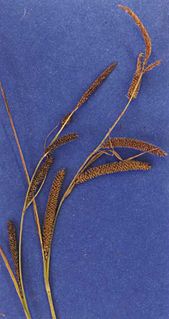
Carex angustata is a species of sedge known by the common name widefruit sedge. It is native to the western United States from Washington and Idaho to California, where it grows in wet meadows and on streambanks.
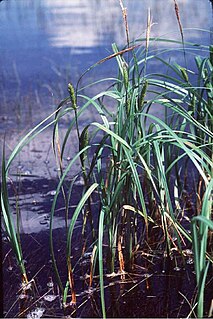
Carex atherodes is a species of sedge known by the common name wheat sedge. It is native to Eurasia and much of North America including most of Canada and the United States. It is a very common wetland plant across the American Midwest and areas west. It grows in moist and wet habitat, such as marshes and moist prairie land, and it may grow in shallow water. This sedge produces triangular, hollow stems 30 to 120 centimeters tall. The leaves are hairy, especially on the lower parts, and the leaf sheath is tinted with reddish purple. The inflorescence is up to 60 centimeters long and made up of several spikes; those spikes near the tip are usually staminate, and those lower in the inflorescence are usually pistillate. The tip of each fruit has two or more long, thin teeth.
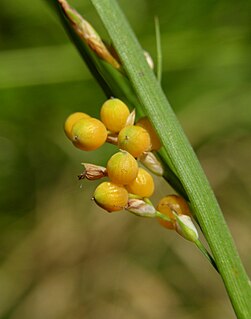
Carex aurea is a species of sedge known by the common name golden sedge. It is native to much of North America, including most of Canada and the western, upper Midwest, and northeastern United States. It grows in wet habitat, often on soils of a basic pH.

Carex douglasii is a species of sedge known by the common name Douglas' sedge.
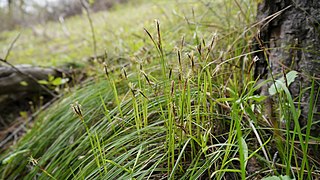
Carex geyeri is a species of sedge known by the common names Geyer's sedge and elk sedge. It is native to western North America from British Columbia to California to Colorado, where it grows in dry areas in mountain meadows, grasslands, and open forest. This sedge produces scattered tufts of stems connected by a network of long rhizomes. The stems are triangular in cross-section and approach half a meter in maximum height. The inflorescence is composed of a cluster of staminate flowers and a cluster of pistillate flowers separated by a node.

Carex hassei is a species of sedge known by the common name salt sedge. It is native to western North America from British Columbia to Baja California to New Mexico, where it grows in moist places, such as meadows.

Carex multicaulis is a species of sedge known by the common name manystem sedge. It is native to California, western Nevada, and southern Oregon, where it grows in chaparral and open forest montane habitats.
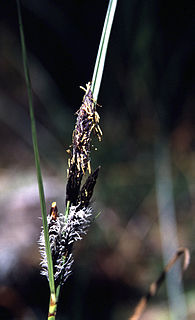
Carex obnupta is a species of sedge known by the common name slough sedge. It is native to western North America from British Columbia to California where it grows abundantly in wet, often saline habitat such as wetlands. The plant produces upright, angled stems approaching 1.2 meters in maximum height, growing in beds or colonies from rhizome networks. The inflorescence is a cluster of flower spikes accompanied by a long leaflike bract. The pistillate spikes and sometimes the staminate spikes dangle on peduncles. The fruit is coated by a hard, tough, shiny perigynium which is generally dark in color.
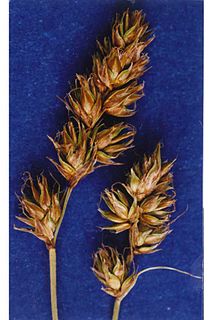
Carex occidentalis is a species of sedge known by the common name western sedge. It is native to the southwestern United States and parts of the west as far north as Montana. It grows mainly in dry habitat such as woodland and grassland. The plant produces very narrow stems up to about 90 centimeters in maximum height, sometimes with rhizomes. The inflorescence produces a cluster of several rounded flower spikes. The pistillate flowers are covered in scales which are brown with green, three-veined centers.

Carex leporina is a species of sedge known in the British Isles as oval sedge and in North America as eggbract sedge. It is native to Eurasia and eastern and western North America, where it grows in seasonally wet habitat, such as meadows and fields. This sedge produces many thin stems and narrow leaves. The inflorescence is an open cluster of several flower spikes. The pistillate flower has a reddish or brownish bract with a gold center and white tip.
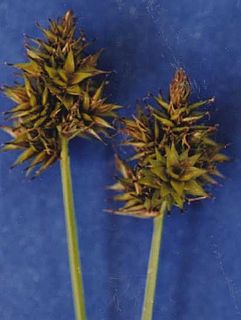
Carex pachystachya is a species of sedge known by the common name Chamisso sedge.
Carex klamathensis is a rare species of sedge known by the common name Klamath sedge. It is known from 15 or fewer populations in southern Oregon and three populations in the Klamath Region of northern California. It was described to science only in 2007. Its habitat includes fens and other wet habitat, on serpentine soils. It was discovered independently by botanists Peter Zika and Lawrence Janeway.

Carex specuicola is a rare species of sedge known by the common name Navajo sedge. It is native to a small section of the Colorado Plateau in the United States, its distribution straddling the border between Utah and Arizona, and completely within the Navajo Nation. There are several populations but they are limited to a specific type of habitat. The plants grow from the sides of steep, often vertical cliffs of red Navajo Sandstone, in areas where water trickles from the rock. It occurs at elevations between 5,700 and 6,000 feet, usually in shady spots. Though it is not a grass, the sedge grows in inconspicuous clumps resembling tufts of grass sticking out of the rock face. When the sedge was federally listed as a threatened species in 1985, it was known from only three populations in Coconino County, Arizona, with no more than 700 plants existing. The species has since been observed in northeastern Arizona and San Juan County, Utah.
Carex garberi is a species of sedge known by the common names elk sedge and Garber's sedge native to North America.

Carex livida is a species of sedge known by the common names livid sedge and pale sedge.
Carex lemmonii, or Lemmon's sedge, is a plant in the sedge family, and is endemic to California. Carex albida is now considered a synonym, but was previously thought to be a separate species; such plants have the common name white sedge.

Carex eburnea, known as ivory sedge, ebony sedge, and bristleleaf or bristle-leaved sedge, is a small and slender sedge native to North America, from Alaska and Newfoundland south to central Mexico.

Carex blanda, the common woodland sedge or eastern woodland sedge, is a sedge native to a wide variety of habitats in the eastern and central United States and Canada.

















